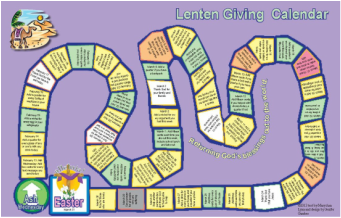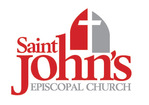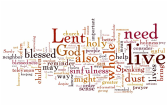
An Article from: www.Barnabasinchurches.org.uk
Talking with your Children about Lent
Lent and Easter - Many people are accustomed to marking the Church’s year in church, but this can also be an important part of the pattern of your year in the home. If you are a parent, use the ideas here to think about how you could mark Lent with your children. Don’t try and do everything with them, or tell them all the information that is included here! Choose the things that you feel would be most appropriate for you and your family. However, this isn’t just for people with children at home. Anyone can make many of these practices and patterns part of their home life during Lent. Bible references are included, and these are intended more for adults to read for themselves, or for older children and teenagers. If you have a children’s Bible, you could find the equivalent passages there to share with your children. On some days, you could leave a Bible open at an appropriate passage, or mark the passage with an eye-catching bookmark.
Here goes…
1. Lent
Talk with your children about why we mark Lent. Lent is the forty days before Easter. In case you try and count the days, take note that the forty days doesn’t include Sundays. Lent reminds us of the forty days that Jesus spent in the wilderness, getting ready for his ministry. Traditionally, it is regarded as a time of denial (hence the tradition of ‘giving something up’ for Lent) and repentance. It can help children to understand more about the purpose of Lent if you also talk in terms of it being a time of ‘getting ready’, of getting ready to celebrate the great festival of Easter, (just as Advent is a time of ‘getting ready’ to celebrate the great festival of Christmas). The story of Jesus in the wilderness can be found in St. Matthew’s Gospel, chapter 4, verses 1 to 11.
2. Shrove Tuesday
The day before Lent starts is Shrove Tuesday, commonly known as “Pancake Day”. Shrove means pronounced forgiven for sins. Many years ago, people would go to church to be shriven, on the day before Lent starts, to confess their sins and receive forgiveness. Because Lent would be a time of meagre eating, pancakes were a means of using up all fine flour, eggs and milk in the house, in preparation.
On Shrove Tuesday have a family pancake party and talk about the tradition of Shrove Tuesday.
3. Ash Wednesday
Lent starts on Ash Wednesday. Ashes were a very old symbol of mourning and repentance, and in some churches they are used in the worship on Ash Wednesday. Traditionally, the ash is made by burning the leftover palm crosses from the previous year, and mixing this with a bit of water. The minister uses the ash to make the sign of the cross on each person’s forehead, as a symbol of our need for Jesus in our lives. You may feel that this is a strange custom, but children are often keen to take part in this if they have the opportunity.
On Ash Wednesday, talk about why this day gets its name. Encourage everyone in your family to make a Lenten resolution. This could be something that you will do to help others, for example, giving a regular amount of money to a particular charity or cause. One way in which you could do this as a family, is to agree which charity or cause you will support during Lent, put a suitable pot on your table, and then agree that you will make a contribution at the main meal of each day. If your children have money of their own, they can be encouraged to give a small amount themselves, but even if this is not appropriate, it is valuable that they see their parents doing this.
People often talk about ‘giving up’ particular food or drink for Lent, e.g. chocolate, sweets, or alcohol. If this is going to be part of your faith observance in Lent, it is important to recognise its significance in faith terms. Giving something up that we really enjoy doesn’t mean that whatever is being given up is necessarily wrong in itself, but the act of giving something up for a period of time can be a means of coming closer to God. It helps to remind us of all the things that we don’t really need, and of our ultimate dependence on God. It can help us to be more aware of temptation and of our need of God’s help in resisting temptation. It can also help us to appreciate the gifts we have when parts of the world have so little.
Another idea linked to the idea of ‘giving up’ something, is ‘giving up’ a regular amount of time each day, perhaps to benefit others or to spend some quality time with God, perhaps by sharing in some appropriate Lent reading together or praying together. Barnabas produces some very good books that you could share with your children during Lent.
Play and Pray through Lent by Kay Warrington. This book uses a simple storycloth with ‘easy to find’ objects, to re-tell 7 passages from the Bible in short daily “episodes”. There are also suggestions for how the daily ideas can be incorporated into the Sunday worship. If you and some other parents would like to use this book with your children during Lent, do talk to your minister about how the ‘Sunday worship activities’ could be incorporated into your church’s worship.
The Easter Experience by Rachel Heathfield includes a daily Bible verse to think about, some thoughts to help children focus on aspects of their own experience which connect with the passage, and ideas for simple activities to help them think further about the passage.
4. Mothering Sunday
Mothering Sunday is the fourth Sunday in Lent. Traditionally it’s a day for having a break from the gloom of Lent. (The tradition of keeping this particular Sunday as Mothering Sunday goes back to Roman times when, as the Christian Church spread, there developed the pattern of honouring the Church as a Mother figure. From this, there developed the tradition of children honouring their mothers on this day. When youngsters worked away from home, they were allowed to go home and visit their mothers on this day, and might take a Simnel cake as a gift.)
You could make or buy a Simnel cake to eat on Mothering Sunday. A Simnel cake is a fruit cake with a layer of marzipan baked inside, and eleven marzipan eggs on the top, symbolising eleven of Jesus’ disciples. (The one missing stands for Judas Iscariot who betrayed Jesus.) An easy way of making something like a Simnel cake is to buy a fruit cake and some marzipan. Roll out the marzipan to a size that will cover the top of the cake and leave enough left over to make 11 small balls or egg shapes. Melt some marmalade or apricot jam in a saucepan and brush over the top of the fruit cake. Lay the marzipan on top. Make 11 balls from the leftover marzipan, and put them around the edge of the top. Brown lightly under the grill
5. Palm Sunday
Palm Sunday is the day when we remember Jesus riding into Jerusalem. Crowds came out to cheer him, wave palm branches and lay down their coats on the ground. See St. Marks’ Gospel, chapter 11, verse 1- 11
If you are given Palm crosses at church on Palm Sunday, bring them home and arrange them in a prominent place in your home. Alternatively, write on the date and use it as a bookmark, perhaps in a Bible. Children could use one as a marker in their children’s Bible.
6. Maundy Thursday
Maundy Thursday is the day before Good Friday. On this day, we remember the Last Supper that Jesus shared with his disciples. ‘Maundy’ comes from a Latin word which means a command, and it refers to Jesus’ command that he gave at the Last Supper, that we must love one another as he loves us. (St. John’s Gospel, chapter 15, verse 12). At the Last Supper, Jesus washed his disciples’ feet, (St. John’s Gospel, chapter 13, verses 1-9) and took the bread and the wine as signs of his body and blood which would be given for us through his death (St. Mark’s Gospel, chapter 14, verses 17-25).
Include some bread and wine/grape juice as part of your main meal on Maundy Thursday. Talk about the Last Supper, the last meal that Jesus shared with his disciples.
7. Good Friday
Good Friday is the day on which we remember that Jesus died on the cross. Children always ask why this day is called ‘Good’. Some people say that it was originally ‘God’s Friday’ and that the name we know developed from that. Another way of looking at it is to explain that although this was an awful day for Jesus, what he did was good for us. However, it is important to try and enter into the sadness and cruelty of this day in some way, and in a way that is appropriate for you and your children, even if only for a short time. Today, the mood of Good Friday is more difficult to appreciate because in many ways it seems like any other day, but you will enter into the joy of Easter Day so much more if you have been able to enter into something of the sadness of Good Friday.
On Good Friday, you could make Hot Cross Buns together and talk about why we have a cross on the top. If you are not big home bakers, you could do this more easily by buying a packet bread mix. Although hot cross buns are in the shops for a long time before Good Friday, I suggest only having hot cross buns on Good Friday, because this then adds to their significance.
You could also plant some seeds, either in the garden, a window box or in pots. This helps us to think about the death of Jesus and his burial. When the seeds start to shoot and grow, you can then also talk about the new life that has come from the seeds that were buried in the ground.
Talking with your Children about Lent
Lent and Easter - Many people are accustomed to marking the Church’s year in church, but this can also be an important part of the pattern of your year in the home. If you are a parent, use the ideas here to think about how you could mark Lent with your children. Don’t try and do everything with them, or tell them all the information that is included here! Choose the things that you feel would be most appropriate for you and your family. However, this isn’t just for people with children at home. Anyone can make many of these practices and patterns part of their home life during Lent. Bible references are included, and these are intended more for adults to read for themselves, or for older children and teenagers. If you have a children’s Bible, you could find the equivalent passages there to share with your children. On some days, you could leave a Bible open at an appropriate passage, or mark the passage with an eye-catching bookmark.
Here goes…
1. Lent
Talk with your children about why we mark Lent. Lent is the forty days before Easter. In case you try and count the days, take note that the forty days doesn’t include Sundays. Lent reminds us of the forty days that Jesus spent in the wilderness, getting ready for his ministry. Traditionally, it is regarded as a time of denial (hence the tradition of ‘giving something up’ for Lent) and repentance. It can help children to understand more about the purpose of Lent if you also talk in terms of it being a time of ‘getting ready’, of getting ready to celebrate the great festival of Easter, (just as Advent is a time of ‘getting ready’ to celebrate the great festival of Christmas). The story of Jesus in the wilderness can be found in St. Matthew’s Gospel, chapter 4, verses 1 to 11.
2. Shrove Tuesday
The day before Lent starts is Shrove Tuesday, commonly known as “Pancake Day”. Shrove means pronounced forgiven for sins. Many years ago, people would go to church to be shriven, on the day before Lent starts, to confess their sins and receive forgiveness. Because Lent would be a time of meagre eating, pancakes were a means of using up all fine flour, eggs and milk in the house, in preparation.
On Shrove Tuesday have a family pancake party and talk about the tradition of Shrove Tuesday.
3. Ash Wednesday
Lent starts on Ash Wednesday. Ashes were a very old symbol of mourning and repentance, and in some churches they are used in the worship on Ash Wednesday. Traditionally, the ash is made by burning the leftover palm crosses from the previous year, and mixing this with a bit of water. The minister uses the ash to make the sign of the cross on each person’s forehead, as a symbol of our need for Jesus in our lives. You may feel that this is a strange custom, but children are often keen to take part in this if they have the opportunity.
On Ash Wednesday, talk about why this day gets its name. Encourage everyone in your family to make a Lenten resolution. This could be something that you will do to help others, for example, giving a regular amount of money to a particular charity or cause. One way in which you could do this as a family, is to agree which charity or cause you will support during Lent, put a suitable pot on your table, and then agree that you will make a contribution at the main meal of each day. If your children have money of their own, they can be encouraged to give a small amount themselves, but even if this is not appropriate, it is valuable that they see their parents doing this.
People often talk about ‘giving up’ particular food or drink for Lent, e.g. chocolate, sweets, or alcohol. If this is going to be part of your faith observance in Lent, it is important to recognise its significance in faith terms. Giving something up that we really enjoy doesn’t mean that whatever is being given up is necessarily wrong in itself, but the act of giving something up for a period of time can be a means of coming closer to God. It helps to remind us of all the things that we don’t really need, and of our ultimate dependence on God. It can help us to be more aware of temptation and of our need of God’s help in resisting temptation. It can also help us to appreciate the gifts we have when parts of the world have so little.
Another idea linked to the idea of ‘giving up’ something, is ‘giving up’ a regular amount of time each day, perhaps to benefit others or to spend some quality time with God, perhaps by sharing in some appropriate Lent reading together or praying together. Barnabas produces some very good books that you could share with your children during Lent.
Play and Pray through Lent by Kay Warrington. This book uses a simple storycloth with ‘easy to find’ objects, to re-tell 7 passages from the Bible in short daily “episodes”. There are also suggestions for how the daily ideas can be incorporated into the Sunday worship. If you and some other parents would like to use this book with your children during Lent, do talk to your minister about how the ‘Sunday worship activities’ could be incorporated into your church’s worship.
The Easter Experience by Rachel Heathfield includes a daily Bible verse to think about, some thoughts to help children focus on aspects of their own experience which connect with the passage, and ideas for simple activities to help them think further about the passage.
4. Mothering Sunday
Mothering Sunday is the fourth Sunday in Lent. Traditionally it’s a day for having a break from the gloom of Lent. (The tradition of keeping this particular Sunday as Mothering Sunday goes back to Roman times when, as the Christian Church spread, there developed the pattern of honouring the Church as a Mother figure. From this, there developed the tradition of children honouring their mothers on this day. When youngsters worked away from home, they were allowed to go home and visit their mothers on this day, and might take a Simnel cake as a gift.)
You could make or buy a Simnel cake to eat on Mothering Sunday. A Simnel cake is a fruit cake with a layer of marzipan baked inside, and eleven marzipan eggs on the top, symbolising eleven of Jesus’ disciples. (The one missing stands for Judas Iscariot who betrayed Jesus.) An easy way of making something like a Simnel cake is to buy a fruit cake and some marzipan. Roll out the marzipan to a size that will cover the top of the cake and leave enough left over to make 11 small balls or egg shapes. Melt some marmalade or apricot jam in a saucepan and brush over the top of the fruit cake. Lay the marzipan on top. Make 11 balls from the leftover marzipan, and put them around the edge of the top. Brown lightly under the grill
5. Palm Sunday
Palm Sunday is the day when we remember Jesus riding into Jerusalem. Crowds came out to cheer him, wave palm branches and lay down their coats on the ground. See St. Marks’ Gospel, chapter 11, verse 1- 11
If you are given Palm crosses at church on Palm Sunday, bring them home and arrange them in a prominent place in your home. Alternatively, write on the date and use it as a bookmark, perhaps in a Bible. Children could use one as a marker in their children’s Bible.
6. Maundy Thursday
Maundy Thursday is the day before Good Friday. On this day, we remember the Last Supper that Jesus shared with his disciples. ‘Maundy’ comes from a Latin word which means a command, and it refers to Jesus’ command that he gave at the Last Supper, that we must love one another as he loves us. (St. John’s Gospel, chapter 15, verse 12). At the Last Supper, Jesus washed his disciples’ feet, (St. John’s Gospel, chapter 13, verses 1-9) and took the bread and the wine as signs of his body and blood which would be given for us through his death (St. Mark’s Gospel, chapter 14, verses 17-25).
Include some bread and wine/grape juice as part of your main meal on Maundy Thursday. Talk about the Last Supper, the last meal that Jesus shared with his disciples.
7. Good Friday
Good Friday is the day on which we remember that Jesus died on the cross. Children always ask why this day is called ‘Good’. Some people say that it was originally ‘God’s Friday’ and that the name we know developed from that. Another way of looking at it is to explain that although this was an awful day for Jesus, what he did was good for us. However, it is important to try and enter into the sadness and cruelty of this day in some way, and in a way that is appropriate for you and your children, even if only for a short time. Today, the mood of Good Friday is more difficult to appreciate because in many ways it seems like any other day, but you will enter into the joy of Easter Day so much more if you have been able to enter into something of the sadness of Good Friday.
On Good Friday, you could make Hot Cross Buns together and talk about why we have a cross on the top. If you are not big home bakers, you could do this more easily by buying a packet bread mix. Although hot cross buns are in the shops for a long time before Good Friday, I suggest only having hot cross buns on Good Friday, because this then adds to their significance.
You could also plant some seeds, either in the garden, a window box or in pots. This helps us to think about the death of Jesus and his burial. When the seeds start to shoot and grow, you can then also talk about the new life that has come from the seeds that were buried in the ground.

Holy Week Activities for Families in the Home
Holy Week and Easter Season Resources for the Home
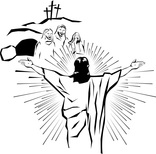
He is alive! Alleluia!
Here are some online resources for you to use with your family at home during Holy Week and the 50 days of The Easter Season.
This is a GREAT way to use the "caves/tombs" made on Palm Sunday in Church School for the entire week to tell the story of Easter! If you weren't able to make Palm Sunday, the caves are made of air dry clay or playdough.
| palm_crosses.docx | |
| File Size: | 31 kb |
| File Type: | docx |
| easter_story_game.pdf | |
| File Size: | 495 kb |
| File Type: | |
| the_easter_story_in_symbols.pdf | |
| File Size: | 450 kb |
| File Type: | |
| easter_story_coloring_pictures.pdf | |
| File Size: | 468 kb |
| File Type: | |
Talking to young Children about the Resurrection
Preschoolers play at home tools
The story of Christ's birth is one of the vital stories of our Christian Faith. As in our Godly Play curriculum children and nursery group should be able to "play with these stories" not only on Sunday but at home. Here is a great example
of a set that is now available at a special price from Fisher Price. All three parts/sets of this creche are offered for
$65.00 on their website. Have this out during the Advent season for children to tell and retell the story of Christ birth.
*They also have a great Noah's Ark set….check that out in the nursery and on the Fisher Price website.
of a set that is now available at a special price from Fisher Price. All three parts/sets of this creche are offered for
$65.00 on their website. Have this out during the Advent season for children to tell and retell the story of Christ birth.
*They also have a great Noah's Ark set….check that out in the nursery and on the Fisher Price website.
http://www.fisher-price.com/shop/little-people-nativity-playset-gift-set-bkb40
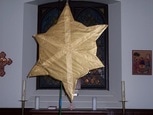
The Season of Epiphany
During this season our Godly Play stories focus on the Parables of Jesus. The Godly Play Foundation has created YouTube videos of many of the parable stories we have chosen this year. We look forward to having you join the Godly Play community on Sundays as reflecting together adds to our stories but, if you unable to join us please take sometime with your child to watch the week's story.
Jan. 15 Holy Baptism https://www.youtube.com/watch?v=Juatr2NVOeY
Jan. 22 The Good Samaritian https://www.youtube.com/watch?v=cC88j6v5keE
Jan. 29 The Great Pearl https://www.youtube.com/watch?v=h-b3T7HfXYY
Feb. 5 The Sower https://www.youtube.com/watch?v=wvfVf13GhYA
Feb. 12 The Mustard Seed https://www.youtube.com/watch?v=qlLiRsDKk7g
Feb. 19 The Parable of Parables No video available-story available upon request
During this season our Godly Play stories focus on the Parables of Jesus. The Godly Play Foundation has created YouTube videos of many of the parable stories we have chosen this year. We look forward to having you join the Godly Play community on Sundays as reflecting together adds to our stories but, if you unable to join us please take sometime with your child to watch the week's story.
Jan. 15 Holy Baptism https://www.youtube.com/watch?v=Juatr2NVOeY
Jan. 22 The Good Samaritian https://www.youtube.com/watch?v=cC88j6v5keE
Jan. 29 The Great Pearl https://www.youtube.com/watch?v=h-b3T7HfXYY
Feb. 5 The Sower https://www.youtube.com/watch?v=wvfVf13GhYA
Feb. 12 The Mustard Seed https://www.youtube.com/watch?v=qlLiRsDKk7g
Feb. 19 The Parable of Parables No video available-story available upon request
| childrensbooks.pdf | |
| File Size: | 352 kb |
| File Type: | |
Ash Wednesday and Lent at Home for Families
Ash Wednesday at Home: Fire and Ashes
Ideas for you to use at home on or around Ash Wednesday
http://www.buildfaith.org/ash-wednesday-home-fire-ashes/
Ideas for you to use at home on or around Ash Wednesday
http://www.buildfaith.org/ash-wednesday-home-fire-ashes/
Also Check Out Our Resource Table at St. John's in the Parish Hall
Easter Basket Treasures
To bring you faith into your child's Easter Basket we would suggest one of these five
beautifully illustrated
and written books described on the link below.
To bring you faith into your child's Easter Basket we would suggest one of these five
beautifully illustrated
and written books described on the link below.
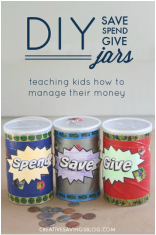
Teaching our Children how to Tithe.......
a timely subject as we enter our stewardship time at St. John's Church
..check out the article below..
http://parenting.blogs.nytimes.com/2015/10/28/to-teach-children-to-give-tell-them-how-much-your-family-has-been-given/?xid=soc_socialflow_facebook_realsimple&_r=0
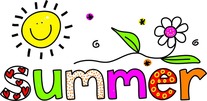
Summer Offerings from St. John's Parish
Families are traveling many weekends during the summer along with summer vacations and activities making it hard to always worship with us here at St. John's. Here are some offerings to keep us connected with your friends here and with your faith during the summer months.
Families are traveling many weekends during the summer along with summer vacations and activities making it hard to always worship with us here at St. John's. Here are some offerings to keep us connected with your friends here and with your faith during the summer months.
| flat_jesus.docx | |
| File Size: | 29 kb |
| File Type: | docx |
Resources for Parents in Response to the Charleston Tragedy
The National Association of Christian Formation Specialist has offered a resource listing information about Black History to be used by adults working with children and parents. Since we are all out of classes and school I pass this on to any parents who might want to discuss this with their youth or older children. There is also a bibliography of books for all ages (including young children). Again this is a resource for adults to delve into and find what is appropriate in your particular enviroment.
The National Association of Christian Formation Specialist has offered a resource listing information about Black History to be used by adults working with children and parents. Since we are all out of classes and school I pass this on to any parents who might want to discuss this with their youth or older children. There is also a bibliography of books for all ages (including young children). Again this is a resource for adults to delve into and find what is appropriate in your particular enviroment.
| teaching_opportunities_in_response_to.docx | |
| File Size: | 93 kb |
| File Type: | docx |
Getting Ready to Begin Our Godly Play Year
"Where has the summer gone" is a phrase I keep hearing over and over again from adults and parents realizing it is once again time for our children to go back to school and like many other families, go back to Church. You can begin this transition into the active year by melding these two areas of your life. As you plan for your child's new year at school and talk with them with "wondering questions" about this new experience: "I wonder what it will be like in your new classroom", "I wonder if you will have any new classmates" or "I wonder what your new teacher is like". Add a simple prayer for the year. Below are a few ideas that you can use, edit, or let them inspire you to crate your own….
O God, I love your world. Thank you for everything.
Please take care of my family- (name family members including animals!).
Help me to be kind and fair to my friends.
~~~~~~~~~~~~~ ~~~~
God is great,
God is good,
Let us thank God for…(have each member say one thing they are thankful for)
God is great,
God is good,
I am sorry and ask you to forgive me God for..
(have each member say/aloud or to themselves something they are sorry for)
God is great,
God is good,
Let us ask God to be with…..(have each member think of one person/etc to ask prayers for)
~~~
Dear God…..Bless my son/daughter today as she begins (goes off to) school….be with her throughout the day.
"Where has the summer gone" is a phrase I keep hearing over and over again from adults and parents realizing it is once again time for our children to go back to school and like many other families, go back to Church. You can begin this transition into the active year by melding these two areas of your life. As you plan for your child's new year at school and talk with them with "wondering questions" about this new experience: "I wonder what it will be like in your new classroom", "I wonder if you will have any new classmates" or "I wonder what your new teacher is like". Add a simple prayer for the year. Below are a few ideas that you can use, edit, or let them inspire you to crate your own….
O God, I love your world. Thank you for everything.
Please take care of my family- (name family members including animals!).
Help me to be kind and fair to my friends.
~~~~~~~~~~~~~ ~~~~
God is great,
God is good,
Let us thank God for…(have each member say one thing they are thankful for)
God is great,
God is good,
I am sorry and ask you to forgive me God for..
(have each member say/aloud or to themselves something they are sorry for)
God is great,
God is good,
Let us ask God to be with…..(have each member think of one person/etc to ask prayers for)
~~~
Dear God…..Bless my son/daughter today as she begins (goes off to) school….be with her throughout the day.
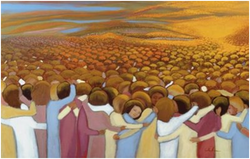 The Communion of All the Saints
The Communion of All the Saints
All Saints Day is November 1st.
Many parishes celebrate All Saints on the first Sunday of November. There are many layers of celebration that day. We remember all those who have passed on in the last year. We remember the "Saints" of the church and we remember those around us who have shown through their
lives their Christian faith. Have a discussion with your family
who might be someone they would consider a present day
"saint" and what would be some qualities they might feel a
contemporary saint might possess.
Many parishes celebrate All Saints on the first Sunday of November. There are many layers of celebration that day. We remember all those who have passed on in the last year. We remember the "Saints" of the church and we remember those around us who have shown through their
lives their Christian faith. Have a discussion with your family
who might be someone they would consider a present day
"saint" and what would be some qualities they might feel a
contemporary saint might possess.
Lent 2013
Today, Lent 1, our children learned the story that Jesus told about the woman who gave all she was able. Our curriulum calls this story, "The Woman's Mite". The definition of "mite" is; a contribution that is small but is all that a person can afford. Many of us remember the "mite boxes" we used to get during Lent to use to contribute a small amount each day. So, today we made our modern version of a mite box. We are calling ours Stain Glass Mite Jars (see pictures above and below). Each child in church school this morning created one and received a calendar for their Lenten Journey with questions and ways to contribute in their Mite Jars. At the end of Lent, we will collect the money and look through the Episcopal Relief and Development's "Gifts for Life" catalog deciding together what to purchase for those in need. Click on the image above to get your own Lenten Giving Calendar.
Another way to use our Mite containers would be to use the "How Many" Game. This can be used at anytime (not just Lent). Play it as a game or pull one card each time the family eats together for partners to look up the answers.
Today, Lent 1, our children learned the story that Jesus told about the woman who gave all she was able. Our curriulum calls this story, "The Woman's Mite". The definition of "mite" is; a contribution that is small but is all that a person can afford. Many of us remember the "mite boxes" we used to get during Lent to use to contribute a small amount each day. So, today we made our modern version of a mite box. We are calling ours Stain Glass Mite Jars (see pictures above and below). Each child in church school this morning created one and received a calendar for their Lenten Journey with questions and ways to contribute in their Mite Jars. At the end of Lent, we will collect the money and look through the Episcopal Relief and Development's "Gifts for Life" catalog deciding together what to purchase for those in need. Click on the image above to get your own Lenten Giving Calendar.
Another way to use our Mite containers would be to use the "How Many" Game. This can be used at anytime (not just Lent). Play it as a game or pull one card each time the family eats together for partners to look up the answers.
Click to set custom HTML
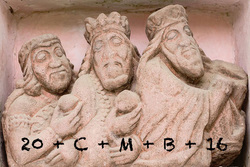
Epiphany chalk house blessing
by Bosco Peters
On Epiphany you can bless your house. You can make this as simple or as intricate as you like; include (liturgical) greeting (eg. “The Lord be with you…”), song or carol, holy water (sprinkling door, each room), reading (eg. Epiphany Gospel, start of John’s Gospel), more prayers, Lord’s Prayer, incense, assigning parts to different members of the household, collect for Epiphany. Many homes are the dwelling for one person – the blessing of a home is equally appropriate.
Take (blessed) chalk (of any colour) and mark on the lintel of your front door 20 + C + M + B + 15 saying:
The three Wise Men,
C Caspar,
M Melchior,
B and Balthasar followed the star of God’s Son who became human
20 two thousand
15 and fifteen years ago .
++ May Christ bless our home and remain with us throughout the new year. Amen.
God is love, and those who abide in love abide in God, and God abides in them. Christ, God’s incarnation, is present in the love and care we manifest to each other in our ordinary daily lives together.
Other possible prayers:
May all who come to our home this year rejoice to find Christ living among us; and may we seek and serve, in everyone we meet, that same Jesus who is your incarnate Word, now and forever. Amen.
God of heaven and earth, you revealed your only-begotten One to every nation by the guidance of a star. Bless this house and all who inhabit it. Fill us with the light of Christ, that our concern for others may reflect your love. We ask this through Christ our Saviour. Amen.
Loving God, bless this household. May we be blessed with health, goodness of heart, gentleness, and abiding in your will. We ask this through Christ our Saviour. Amen.
It is in the home that the first experience of love occurs; it is there that love is nurtured and grows to maturity. The Christian home is also the ground for much of people’s spiritual growth.
The ministry of Jesus occurs in many different homes. Therefore to hallow the home as an environment for nurture and renewal, is a deeply felt need by many Christian households.
The blessing of a home encourages Christians to dedicate their life at home to God and to others.
From A New Zealand Prayer Book page 762
C M B above the door, also stands for Christus Mansionem Benedicat, Latin for “May Christ Bless this House.”

